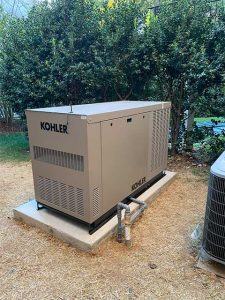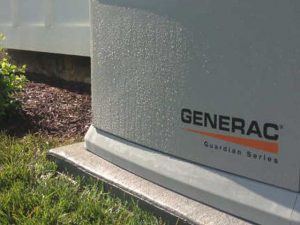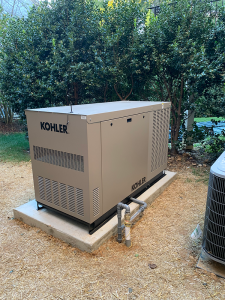How often have you seen your electric grid go down after a loud crack of thunder and a brilliant flash of lightning? Most of the time, all this happens in seconds, and it takes one or two minutes to realize what happened just now. The lights have gone out, there is a terrible hush in the air, and there is nothing you can do except wait around.
There is no way to prevent power outages because they strike anywhere and anytime and may become more prolonged and more frequent. It should be no surprise that strong storms cause about 60 percent of all power outages. What is surprising is that equipment malfunctioning or failure is to blame for 34% of outages. This is primarily due to the country’s old and overstrained electrical infrastructure.
Outages of the electrical supply are unavoidable; nevertheless, just because they are inevitable does not imply that you must tolerate them. With the assistance of a backup generator, you may very literally emerge from the shadows and into the light.
These awesome gadgets are your electrical power source. The backup generator in your house will begin supplying electricity to your home’s electrical circuits as quickly as a few seconds after a power outage occurs. Often, this happens so fast that you may be unaware that a power outage occurred.
If you’re like most other Americans, you probably spent more time at home in the last year than you ever had in the years before because you or your spouse may be employed remotely. In such situations, there is no doubt that a power outage might be inconvenient to both of you as your work heavily depends on the uninterrupted power supply.
If you want to be ready for the next power outage, now is an excellent time to start thinking about investing in a backup generator. However, before taking this step, consult professionals and learn how to size a standby generator for your home in McLean, VA. This will help you avoid unnecessary financial obligations while shopping for a standby generator.
What Is a Standby Generator?
The answer is simple. A standby generator functions as a backup power source for your home when your electrical grid suddenly fails. It works automatically within a few seconds after a power outage. Are you wondering how? It is simple. Once a power outage is detected, your home’s electrical load is automatically transferred to the generator. All the electrical appliances you have connected to the generator at the installation time will continue to work uninterrupted as if a blackout never occurred.
Portable and backup generators are the two basic categories of generators. There is a massive difference between these two types of generators, even though they both do the same core task.
• Portable generators are usually powered by gasoline. If your electricity goes out, you must take it out of storage, connect it to the electric grid in your house, and manually start it up.
• A home standby generator or a whole-house generator is installed outside your house permanently. It can detect a power outage and switch itself on with the aid of an ATS (automatic transfer switch) without any type of manual intervention. It may be powered by propane or natural gas as the situation demands.
Every year, several households are left in the dark due to power outages brought on by technical issues, storms, and other circumstances. Suppose you have a standby generator installed at your home. In that case, you will never have to deal with the uncomfortable situation of losing power to your air conditioner, refrigerator, or other appliances. Most people are already familiar with the function of backup generators. However, the following provides more information on how ATS operates.
How does ATS or Automatic Transfer Switch Work?
Thanks to standby generators’ automatic transfer switches (ATS), users can get continuous power. The main circuit breaker of the building is controlled by an automated transfer switch (ATS) that certain types of generators have. In contrast, other models have a circuit breaker built into their automatic transfer switches. If there is a disruption in the power supply, the transfer switch will disconnect from the grid’s supply and connect to the generator. This takes less than a minute to complete.
It’s possible that a less powerful standby generator won’t be able to keep every piece of electric equipment in your home operating for many hours straight. The system decides which appliances to power, depending on the priorities you have specified in advance during the generator installation. Until power is fully restored, essential high-load appliances like the air conditioner, stove, and refrigerator will continue to get the energy they need to function correctly.
By controlling the amount of power the system produces, priority-based power management makes it possible for a less powerful generator to power the essential appliances in a house effectively. However, remember that before investing in a standby generator, you should know how to size a standby generator for your home in McLean, VA.
Benefits of Backup Generators
• Reliability: a standby generator can work for days or weeks on a whole-house propane tank or forever if you have natural gas. In other words, it uses fuels that are easily accessible. Depending on the size of your house and how much electricity you consume, a standby generator will typically need between 13 and 48 gallons of liquid propane or natural gas to operate continuously throughout the day.
• Convenience: If there is a disruption in your regular power supply, a backup generator automatically provides electricity to your whole house without manual intervention.
• Works quietly: in contrast to portable generators, which are infamous for their raucous operation, a backup generator’s enclosure is insulated and protected from the elements, so it operates in relative silence.
• Power output: The power output of standby generators ranges anywhere from 8,000 to 20,000 watts, which is much more than the power output of their portable equivalents
• Assurance of one’s safety amid storms: Any form of weather event, such as a hurricane in the summer or an ice storm in the winter, has the potential to abruptly knock off your power supply, which may sometimes last for several hours or even for many days. Investing in a standby generator for your family’s comfort and security can ensure that your home’s appliances, heating and air conditioning system and other essential electrical gadgets continue functioning normally.
Drawbacks of Standby Generators
Remember that standby generators also come with certain drawbacks, similar to any other electrical machinery. So, what are the disadvantages of using these systems? To begin, let’s look at their initial investment. When you factor in the installation cost, these systems often have a heftier price tag than a portable generator since they represent an investment in your property and are more complicated. On the other hand, if you live where power outages are frequent and consistent, investing in a backup generator can be well worth every cent you spend on it.
Second, backup generators are fixed in place and cannot be relocated. Since they must be permanently fixed on your property and connected to a gas line, there will always be a massive box on your land.
Although manufacturers have done an excellent job of making these units appear quite acceptable in almost any yard, they will still be noticeable in most circumstances because of their size and placement. It is also not recommended to hide them with trees or bushes since they depend on airflow to maintain a cool temperature while functioning.
Finally, the permit acquisition procedure may be relatively time-consuming and challenging, depending on your city or county.
Here is how to identify the appropriate size backup generator for your house and what to anticipate when you hire an electrician to install a standby generator.
How to Size a Standby Generator for Your Home in McLean, VA?
Generators come in several sizes. As a general rule, the greater the size of the generator, the more power it can generate. Large generators come at a significant financial premium compared to their more compact counterparts. This information may already be common knowledge. However, we are bringing it up since there are alternatives to buying a generator that can power your entire home.
You can purchase a more compact generator designed to power only a few of the most critical circuits in your home, for example, such as those connected to the heating system, the kitchen appliances, the well pump, the water heater, the security system, the garage door opener, and a select number of lights and outlets. Such generators are sometimes also called “partial-house generators”.
When choosing a standby generator, one of the most important considerations to take into account is the size of the home. The level of complexity of the house’s electrical system is another significant factor, particularly if the property has centralized air conditioning.
If you are seeking an answer to the question, ” How to size a standby generator for your Home in McLean, VA?” let us inform you that it is not as easy as looking at the square foot area of the house. Even though we will cover the fundamentals here, you should still consult a professional electrician so that they can calculate the projected electrical demands in your home and assist you in selecting the appropriately sized generator.
Kilowatts (kW) are used to measure the capacity of standby generators. One kilowatt equals 1000 watts. Hence, the amount of electrical power produced by a generator rated at 22 kW equals 22,000 watts.
In addition, an automated transfer switch, also known as an ATS, which operates as the central processing unit of the standby power system, must be paired with each generator. It relays the on/off command to the generator at the appropriate times. Once again, the electrician will offer direction in this regard. Still, a 200-amp ATS is generally necessary if the generator is connected to a breaker panel that can handle a maximum of 200 amps. You will need a 100-amp ATS if the electrical panel in your house is rated at 100 amps.
In short, the size of the generator is determined by the entire amount of operating watts and starting KVA required by all the circuits, appliances, and mechanical systems linked to the generator. Let us explain the terms KVA and Running Watts a bit more clearly.
KVA is one thousand volt-amps. A volt is the unit of voltage, and an amp is the unit of current. If so, what is starting KVA? To start a standby generator, a starting KVA is necessary every time as it has to manage a surplus electrical surge to get going.
Now let us see what is running watts. This is the power needed by an electrical motor to run uninterrupted. After identifying the standby electrical circuits, the electrician may calculate the total electrical load for the whole system by adding up the starting KVA and all running watts. This calculation will give you the generator size you will need for your home, which will satisfy your house’s total electrical load during a blackout.
Why Should You Choose Us?
• Service – We have a long history of providing unrivalled customer service, and our reputation follows us due to this accomplishment. Every encounter with our customers is supported with vitality derived from our sincere enthusiasm for our work.
• Years of Experience – We are more than “basic electricians;” we are professionals in system integration and design who give complete solutions. We take pride in the fact that we can meet all of our customers’ needs. This differentiates us from the other companies in our industry. We know that every company is different, and we also realize that strategies that work well for one company may not benefit another. This is something we always keep in mind, and this fact has always motivated us to satisfy the needs of every customer who comes to us for assistance regarding their standby generator sizing or any other issue they may be facing while operating a standby generator,
• Competitive pricing – PSI has built its name on the principle that it always offers consumers excellent service at reasonable costs.
• Appropriate Sizing – If you do not have a clear idea about how to size a standby generator for your home in McLean, VA, our professionals can help you. We will ensure that the generator you select is of a size that is enough to satisfy all the requirements of your home without being too large. You can choose the system from our collection most suited to meet your needs since we provide various options, with outputs ranging from 2 kW to 2000 kW.
• Monitoring and Maintenance Services – We provide all-encompassing maintenance plans, which include remote monitoring for those systems that can accommodate them.
Do not be shy about contacting the Power and Systems Integration experts if you are considering having a home backup generator placed in your residence. They will assist you in every step of the process.
Do you need assistance with generator size, installation, maintenance, or repair and are interested in speaking with one of our trained specialists but unsure how to contact them? In such cases, our main website’s online contact form is the quickest and easiest way to contact us. You may contact us by providing your personal information in the space provided on the contact form. Please remember that our capable personnel look forward with great enthusiasm to any chance they have to assist you.
If you still have questions or concerns about purchasing a backup generator for your house. Once we have received your contact information, one of our specialists will contact you and provide further assistance as soon as possible.



